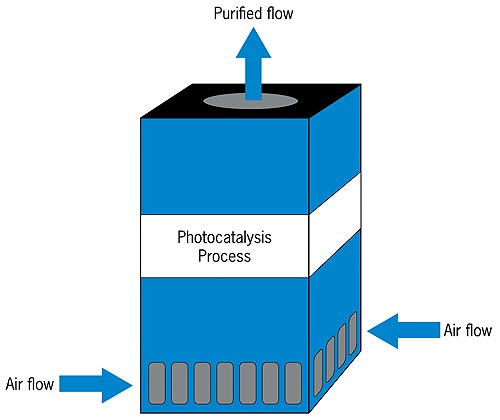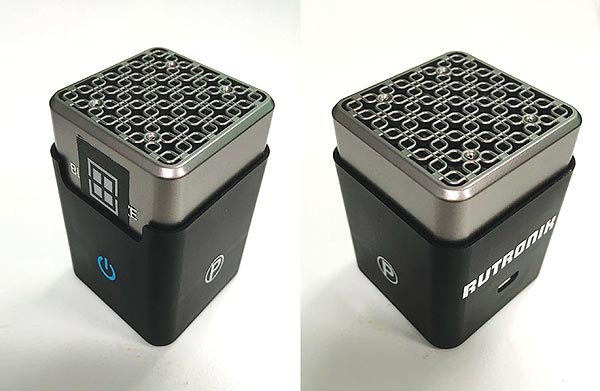 Cigarette smoke, sweat, sulfur, rancid fat, burned food – the sort of things that nobody likes to have to smell. If you can’t get in some fresh air, then this is where filters become useful. UV-assisted, photocatalytic models are especially effective here. Rutronik’s first deodorizer demonstrator is also based on this technology.
Cigarette smoke, sweat, sulfur, rancid fat, burned food – the sort of things that nobody likes to have to smell. If you can’t get in some fresh air, then this is where filters become useful. UV-assisted, photocatalytic models are especially effective here. Rutronik’s first deodorizer demonstrator is also based on this technology.
Many components of odors are volatile organic compounds (VOCs) such as hydrocarbons (such as methane), alcohols (such as ethanol) and organic acids (such as acetic acid). They are present in many objects, cleaning agents and cosmetics, are secreted by living beings, and are produced in various processes, including the anaerobic decomposition of organic substances (rotting). VOCs can not only create unpleasant odors, but also negatively affect our health, well-being and performance. Conversely, air free of such pollutants can be a major boon for our quality of life and health.
Methods for Clean Air
Where the concentration of VOCs in the air cannot be reduced by simply increasing the supply of fresh air, effective air purifiers are an important tool. Some of them not only filter unpleasant odors and contaminants but also neutralize gases and destroy pathogens. There are different classes of devices that can be categorized based on how they function:
Air scrubbers pass the air through water rollers, causing dust particles to stick to the water film, thus filtering them out of the air. Air purifiers are also known as air humidifiers, as the water molecules are dispersed into the surrounding air because of the process.
Ionizers generate negatively charged particles that bind to positively charged particles in the air, causing them to increase their mass and drop to the ground. A major disadvantage of ionization is the production of ozone, which is harmful to health in larger quantities.
Filter systems pass the air through several filters. Their large surface enables them to adsorb these undesired particles, pathogens and odors. The most well-known of these right now is the HEPA filter (high-efficiency particulate air filter) and the activated carbon filter (e.g. In water filters). The filter also acts as a reducing agent to absorb ozone or chlorine.
Photocatalytic filters use titanium dioxide plates that can be exposed to UV light (UV-assisted titan dioxide photocatalysis, UVTP), producing free radicals that break down organic materials such as VOCs, as well as bacteria and viruses.
Light Against Pathogens and Odors
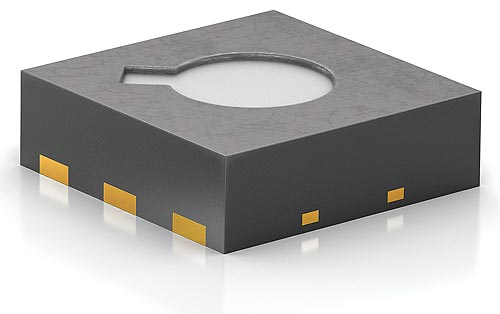 UV-assisted TiO2 photocatalysis is already an established feature of water and wastewater treatment, mostly notably for ensuring the quality of drinking water. Their use in air purifiers is less common. They are used in the construction industry and in some urban centers for reducing the toxic pollutant content of the air. The latest findings indicate that UVTP can also guarantee the microbiological safety of foods.
UV-assisted TiO2 photocatalysis is already an established feature of water and wastewater treatment, mostly notably for ensuring the quality of drinking water. Their use in air purifiers is less common. They are used in the construction industry and in some urban centers for reducing the toxic pollutant content of the air. The latest findings indicate that UVTP can also guarantee the microbiological safety of foods.
Smell the Risk, Before You Risk a Smell
Two studies from the Kanagawa Institute of Industrial Science and Technology (KISTEC) in Japan recently demonstrated using a UVTP-based deodorizer how this method of photocatalysis is extremely effective against odors. The results were confirmed by the Japan Food Research Laboratories. These studies involved acetaldehyde, a gas with a pungent odor, being pumped into a 36-liter tank until a concentration of 10ppm was achieved. The deodorizer was then activated and the concentration was measured over a period of 60 minutes using a photoacoustic multi-gas monitor. The result: After 14 minutes, the share of acetaldehyde was just 0.1ppm, after 23 minutes it was just 0.05ppm. The process was repeated several times, in each case following the same procedure. For a comparison, the institute used an ionizer with the same test construction. This reduced the acetaldehyde concentration by just 40% within an hour. Without any air purification measures, 95% of the acetaldehyde was still present after an hour.
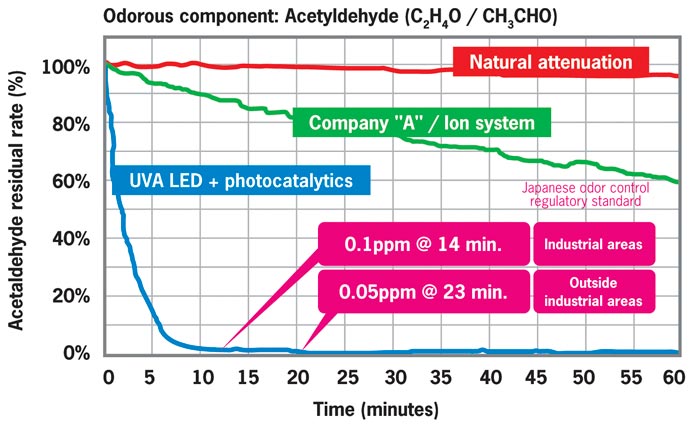
Many odor components can be quickly neutralized using photo catalysis and UVA light. – (© Kanagawa Institute of Industrial Science and Technology (KISTEC))
The same tests produced almost exactly the same results with ammonia (smell of urine), methyl mercaptan (smell of feces) and formaldehyde (smell of pungent cleaning agents). Only in the test series for hydrogen sulfide (rotting and sulfur odor) and trimethylamine (unpleasant fish smell) did the deodorizer need to be used for longer to achieve a comparable result. After two hours, almost all of these VOCs were also barely measurable.

Whether it’s the stench of cigarettes, rotting or chemicals – UV-assisted photo catalysis quickly provides fresh air again. – (© Kanagawa Institute of Industrial Science and Technology (KISTEC))
The UVA-LED NDU1104ESE-365 from Stanley with a wavelength of 365nm proved to be the most effective model for the UV source in the studies. UVA-LEDs with wavelengths of 385nm or 395nm neutralized much fewer VOCs. Its drive current of 500mA also makes the NDU1104ESE-365 more effective than other models with lower values, because light output rises with current (Figure 3).
Deodorizers from Rutronik
Based on these findings, Rutronik has developed a deodorizer demonstrator. At the base of its quadratic housing (48mm x 48mm x 60mm), air flows into the device. A fan ensures that the air moves up from the bottom through the housing, passing through a photocatalytic filter located between two UVA-LEDs with a wavelength of 365nm and a drive current of 500mA (Figure 4).
Rutronik used the SGP MOX sensor from Sensirion to determine the VOC content. It is mounted next to the LED and is based on the “chemisorption” of gases in the presence of oxygen, with the doped O2 atoms of the metal oxide (MOx) bonding with the odor molecules. The electrons that this reaction releases cause a change in the electrical resistance of a film made of metal oxide nanoparticles. This is how the sensor detects a wide variety of VOCs and other gases playing a fundamental role in odors and the quality of a space’s air.
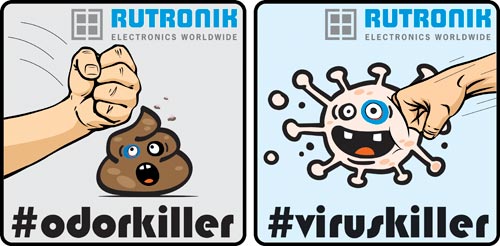 If the number of VOCs exceeds a certain value, the LED is activated. The radiation time is based on the type and quantity of the VOCs. Optionally the values measured by the sensor can also be displayed so that users can always read the air quality values.
If the number of VOCs exceeds a certain value, the LED is activated. The radiation time is based on the type and quantity of the VOCs. Optionally the values measured by the sensor can also be displayed so that users can always read the air quality values.
The rechargeable lithium-ion battery with a charge life of two hours can be charged at any household mains socket, on a PC or using a car charger, making it portable and flexible. This allows businesses to test its effect anywhere, be it in public or portable toilets, trash rooms, industrial kitchens or fitness studios.
The Rutronik deodorizer is still in the test phase – but should it prove to be suitable in practical use, it would be an important step in fighting unpleasant and harmful odors. Moreover, that is when air fresheners, paper air fresheners and room sprays will cease to have any purpose.
Authors:
Maria Alejandra Salazar Martinez,
Product Sales Manager Analog & Sensors
Alain Bruno,
Product Sales Manager Opto
Rutronik | https://www.rutronik.com
![]()



